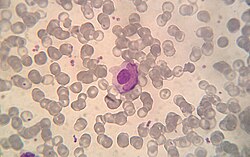
A | B | C | D | E | F | G | H | CH | I | J | K | L | M | N | O | P | Q | R | S | T | U | V | W | X | Y | Z | 0 | 1 | 2 | 3 | 4 | 5 | 6 | 7 | 8 | 9

A lupus erythematosus cell (LE cell), also known as Hargraves cell, is a neutrophil or macrophage that has phagocytized (engulfed) the denatured nuclear material of another cell.[1] The denatured material is an absorbed hematoxylin body (also called an LE body).[2]
They are a characteristic of lupus erythematosus,[3] but also found in similar connective tissue disorders or some autoimmune diseases like in severe rheumatoid arthritis. LE cells can be observed in drug-induced lupus, for example, following treatment with methyldopa.[4]
The LE cell was discovered in bone marrow in 1948 by Malcolm McCallum Hargraves (1903–1982), a physician and practicing histologist at the Mayo Clinic.[5] Hargraves may have gained priority by suppressing a publication draft of John R. Haserick, who credits Dorothy Sundberg, chief hematologist at the University of Minnesota Hospitals, with first identifying LE cells.[6]
Classically, the LE cell is analyzed microscopically, but it is also possible to investigate this phenomenon by flow cytometry.[7]
LE cells shouldn't be confused with Tart cells which have engulfed nuclear material, but with a visible chromatin rather than homogeneous appearance.[8]
References
- ^ "Medical Definition of LE CELL". www.merriam-webster.com.
- ^ similima.com > Autoimmunity Archived 2011-07-27 at the Wayback Machine Muhammed Muneer. Retrieved March 2011
- ^ "LE Cell Test. Lupus erythematosus test". Archived from the original on 2012-03-08. Retrieved 2010-06-28.
- ^ Cheesbrough, Monica (2000-10-26). District Laboratory Practice in Tropical Countries. Cambridge University Press. ISBN 9780521665452.
- ^ Hargraves M, Richmond H, Morton R. Presentation of two bone marrow components, the tart cell and the LE cell. Mayo Clin Proc 1948;27:25–28.
- ^ Discovery of the LE factor Dermatopathology: Practical & Conceptual Archived 5 September 2019 at the Wayback Machine
- ^ Böhm, Ingrid (1 January 2004). "Flow Cytometric Analysis of the LE Cell Phenomenon". Autoimmunity. 37 (1): 37–44. doi:10.1080/08916930310001630325. PMID 15115310. S2CID 218876983.
- ^ Li, Qing Kay; Khalbuss, Walid E. (2015). Diagnostic Cytopathology Board Review and Self-Assessment. Springer, New York, NY. p. 179. doi:10.1007/978-1-4939-1477-7_2. ISBN 9781493914760.
Text je dostupný za podmienok Creative Commons Attribution/Share-Alike License 3.0 Unported; prípadne za ďalších podmienok. Podrobnejšie informácie nájdete na stránke Podmienky použitia.
Antropológia
Aplikované vedy
Bibliometria
Dejiny vedy
Encyklopédie
Filozofia vedy
Forenzné vedy
Humanitné vedy
Knižničná veda
Kryogenika
Kryptológia
Kulturológia
Literárna veda
Medzidisciplinárne oblasti
Metódy kvantitatívnej analýzy
Metavedy
Metodika
Text je dostupný za podmienok Creative
Commons Attribution/Share-Alike License 3.0 Unported; prípadne za ďalších
podmienok.
Podrobnejšie informácie nájdete na stránke Podmienky
použitia.
www.astronomia.sk | www.biologia.sk | www.botanika.sk | www.dejiny.sk | www.economy.sk | www.elektrotechnika.sk | www.estetika.sk | www.farmakologia.sk | www.filozofia.sk | Fyzika | www.futurologia.sk | www.genetika.sk | www.chemia.sk | www.lingvistika.sk | www.politologia.sk | www.psychologia.sk | www.sexuologia.sk | www.sociologia.sk | www.veda.sk I www.zoologia.sk
